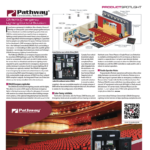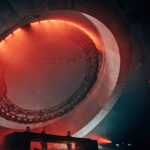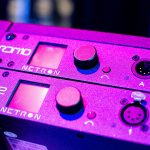In the past decade, the use of drafting software has become rote for designers in this industry, and the available offerings have increased dramatically, with each software package offering various industry-specific tools and an eye toward ease of use, much to the delight of those of us without engineering or CAD degrees. (see PLSN Product Gallery, February 2006 – ed.)
While no single CAD package appears to have gained a majority market share, VectorWorks has probably come closest to being considered a standard. (According to a recent Internet survey conducted by Dennis Dorn and Don Schneider of the University of Wisconsin, of 641 respondents, 47% of them said they use VectorWorks regularly, 37% said they use AutoCAD regularly, and 14% said they regularly use other CAD programs. Of the respondents, 73.3% said they were primarily employed in theatre production, and 58.1% said they were involved in academics. At least in the world of scholastic theatre production, that’s about as close to a standard as you can come. – ed.) Available for Macintosh and Windows operating systems, this CAD offering from Nemetschek North America has grown over time into a highly tailored platform for lighting and scenic designers alongside its other specialty offerings.
With the introduction of VectorWorks 12, Nemetschek continues their efforts to simplify the technical aspect of drafting, giving the designer more time and flexibility to be creative.
What’s in the Package?
VectorWorks software is licensed based on different components, each of which is highly customized for its target industry. Upon purchase, you receive a DVD that includes all of these modules, and a serial number that will unlock the purchased components during install. This allows you to easily add on components at a later date by purchasing an unlock code from the manufacturer.
The most full-featured set of components for a lighting designer would include VectorWorks Fundamentals (the core drafting system), VectorWorks Spotlight (additional tools designed specifically for lighting designers) and RenderWorks (an extended rendering engine).
Fundamentals
The core of the VectorWorks suite, VectorWorks Fundamentals is a fullfeatured CAD platform that is being used by architects and engineers worldwide. For new users, the interface is fairly intuitive, with most commands represented well by icons, or easily found in the menu structure.
For users of other CAD platforms such as AutoCAD, the most noticeable difference (aside from the lack of a command line) will be the concepts of ‘layers’ and ‘classes’. In general, ‘classes’ in VectorWorks are synonymous with ‘layers’ in AutoCAD. Included with all versions of the software is a basic tutorial CD for new users, while more extensive training CDs are available for purchase from the manufacturer. The included tutorials offer a good primer for getting your hands dirty, but don’t go too far above and beyond.
Drafting modes include all manner of 2D and 3D views, including real-time surface shading and high-speed basic renders.
When you move between 2D and 3D modes, VectorWorks supports so-called ‘hybrid’ objects. These objects include a full 3D wireframe as well as a cleaned up 2D symbol that is shown in overhead plan views.
Spotlight and RenderWorks
With the addition of Spotlight, Vector- Works starts to show some real benefits to a lighting designer. An entire complement of specialized tools and symbols are at the ready. Features like fixture, truss and curtain insertion tools take some of the pain out of routine tasks, while a photometer allows you to measure theoretical light levels on stage.
The final add-on to the package is a suite of rendering tools that allows you to produce nearly photo-realistic renderings of lighting looks and scenery.
By using the library of materials in RenderWorks, a little bit of extra time with your drawings can produce life-like images of a set or lighting look.
How It Stacks Up
With version 12 of their software, Nemetschek has done a good job of updating the interface to match modern computer platforms. A simple look and highly configurable layout should allow most people to find their way around with ease.
While Spotlight understands the concepts of light fixtures, trusses and hang positions, it falls somewhere between AutoCAD and WYSIWYG in its follow-through with these objects. 3D insertion of objects can be a bit crude, relying heavily on the height setting for a given layer, as opposed to object snap settings.
Rendering, however, is second-to-none. Basic high-speed and real-time rendering options can be selected while working in the drawing, allowing basic renderings to be seen instantly. The RenderWorks engine is very easy to get the hang of, and becomes even more powerful as you master the use of textures and surface materials.
Another boon is the connectivity offered with ESP Vision pre-visualization technology. VectorWorks drawings are natively supported by Vision, making the move from design to pre-programming a painless process.
Conclusions
This software finds itself on the shelf somewhere between Autodesk’s AutoCAD and Cast’s WYSIWYG products.
Nemetschek offers up more features in the drafting and rendering departments than WYSIWYG, allowing for more detailed drawings and impressive final products. However, they can’t quite match WYSIWYG in the ease-of-use department, especially when it comes to quick 3D drafting.
While AutoCAD has long been the darling of corporate architects and engineers, its complexity is generally un-justified for most LDs. The one place that AutoCAD wins is in their drawing space concepts, which are still light-years ahead of the competition.
Phil Gilbert is a freelance lighting designer / programmer. He can be reached at pgilbert@plsn.com.


